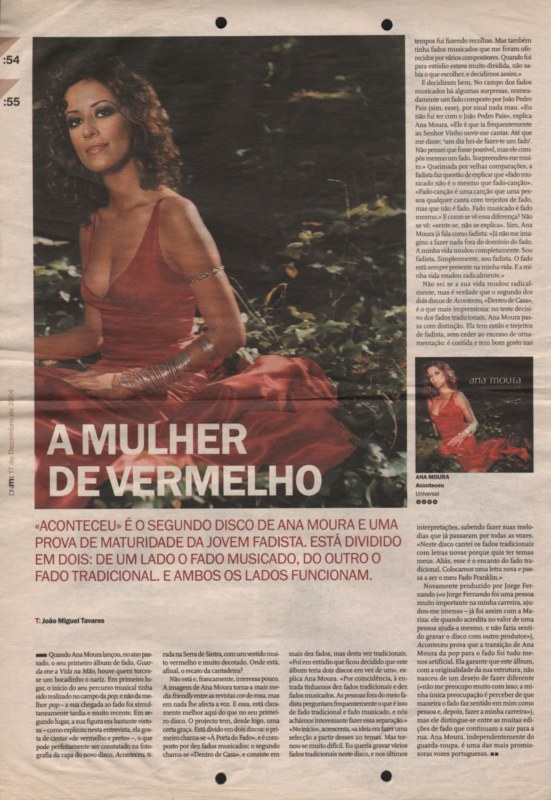Know more:
Ana Moura
(N. 17 September, 1979)There is no other fado voice like Ana Moura’s. A voice that traipses freely through tradition, but that also takes time to flirt elegantly with pop music, to broaden the scope of this Lisbon song form in a highly personal way. But what really sets her apart is not just the deep and sensual timbre that few others can produce, it is her adroitness at instantly transforming into fado any melody she lends her voice to. There is practically no fuse on this emotional explosion, fired unhesitatingly at the listener’s heart.
Fausto, José Afonso, Ruy Mingas, Angolan music and fado. These were the favourites at the Moura family’s musical soirées, in Coruche. Ana Moura was just a slip of a girl - she was born in Santarém, also in the Ribatejo district, in 1979 – with a love of singing. Her parents sang, all her mother’s family sang, and any family get together would always end with music and song. Although she would sing anything, Ana soon began to feel that, for some reason, she had a special fondness for fado. At the age of six, she sang her first fado, “Cavalo Ruço”, and she would also often hear her mother crooning “O Xaile de Minha Mãe". Then came adolescence and she put fado to one side for a while. She got into other types of music, more befitting her age and her school friendships.
In a full-blown adolescence of discoveries and rebellions, and also highly curious about other musical forms, the 14-year old Ana Moura arrived in Carcavelos to start the 10th year at school. She did not come to sing but, rather, to study. She did, however, enrol in the Amateur Music Academy. She formed her first band with school friends. Although she sang other genres, her voice, left to its own devices, rapidly gravitated towards the register required for fado. Even when singing with rock groups, she managed to squeeze one or two fados onto the play list, usually Amália’s “Povo que Lavas no Rio”. Amália was something of an idol to Ana at this stage in her career.
Her experience with this cover band, the "Sexto Sentido", eventually led to her starting to record a pop/rock album with the musician Luís Oliveira, to be released on the multinational Universal label. However, the record was never finished. Destiny intervened and led Ana Moura to a bar in Carcavelos, where she gave in to the temptation to sing fado. The guitarist António Parreira, who was there that night, was so impressed that he took her by the hand and led her on a tour of fado houses. Then, at a Christmas party for musicians and fado singers, as Ana Moura joined in the merrymaking with those who were to inhabit her nights from then on, she was invited to sing a song. The invitation came from Maria da Fé, co-owner of the prestigious Senhor Vinho fado house, who was unable to resist such raw talent. The applause was accompanied by the offer of a resident spot from Maria da Fé.
The Senhor Vinho, and many other houses Ana Moura came to frequent, provided the night-time environment that was to become her true music school. Before, Ana Moura sang fado “just because”, because her intuition told her to, because her mouth seemed to decide on its own. Now, the coaching she received from the older hands, particularly Maria da Fé and Jorge Fernando, gave her other reasons to sing, but without killing her spontaneity.
This passion was so evident that she quickly won over Miguel Esteves Cardoso (MEC). After seeing and hearing the fado singer perform on an António Pinto Basto programme on RTP1 called Fados of Portugal, and before the record companies had even heard of her, MEC’s article served to broadcast the news of her latent talent. After reading MEC’s piece in the Independente, Tozé Brito, a director at Universal, went to Senhor Vinho to hear the voice that he had only ever heard as part of Sixth Sense. He wasted no time in offering a recording deal.
In 2003, Jorge Fernando was asked to produce her début album "Guarda-me a Vida na Mão". In addition to producing the record, Fernando was also responsible for six of the 15 tracks. Ana Moura adopted one of these, “Sou do Fado, Sou Fadista” as something of a signature tune. The collaboration between these two carried over into her next recordings. It was immediately obvious that Ana Moura’s fado has a rare elasticity, as she invited in such co-performers as the Ciganos d’Ouro and Pedro Jóia, and such instruments as the cajón or flamenco guitar. But the heart of the matter remained untouched: tradition held steadfast. Both the public and critics reacted enthusiastically and unequivocally to "Guarda-me a Vida na Mão" and Ana Moura rapidly became a regular performer, first at Portuguese venues, then abroad.
"Aconteceu", in 2004, was a logical continuation of her début album. This double album revealed a surprising ambition, while also showcasing the singer’s amazing confidence and certainty that she is on the right path: one of forging a natural interplay between a more traditional form of fado and a highly personal style that she believes requires contemporaneity.
Ana Moura’s career began to gather such pace that she ended up leaving Senhor Vinho to accept some of the many invitations to perform outside the country. This departure left something of a void, which was later filled when she joined the company of a new fado house in the Alfama, called Casa de Linhares – Bacalhau de Molho. In February 2005, Ana Moura’s international career continued to grow, with a performance at the fabled Carnegie Hall in New York. On the other side of the world, the Rolling Stones’ saxophonist, Tim Ries, walked into Tower Records in Tokyo, looking for fado records. He already had it in mind to include a fado singer in the second volume of his Rolling Stones Project, in which he invited people immersed in different musical genres to perform Rolling Stones songs with one of the band’s longest-serving musicians. He bought three CDs, on a hunch, and it was love at first hearing. Ana recorded “Brown Sugar” and “No Expectations” for the album. She sang the second of these live with the Stones at the Alvalade XXI stadium. Since then, Ana Moura and the Rolling Stones have met up several times while on tour. On one such occasion, in San Francisco, Ries called up the singer to tell her about a song he had written specifically for her voice. “Velho Anjo” appeared on Ana Moura’s next record, "Para Além da Saudade" (2007), after being ‘fado-ed up’ by a Jorge Fernando arrangement.
One of the truly remarkable features of Para Além da Saudade is the participation of Fausto on a recording that is not his own. Ana, who grew up listening to the composer of "Por Este Rio Acima", overcame any hesitancy and asked him for a composition. Another invited composer, this time writing expressly for herself, was Amélia Muge. A duet with the iconic Spanish singer Patxi Andión gives the recording its intercultural flair. In addition to composing, Tim Ries also played saxophone on two of the tracks – “Velho Anjo” and “A Sós com a Noite”. Thanks to the Jorge Fernando track “Os Búzios”, "Para Além da Saudade" scaled to new heights of success for Ana Moura. This culminated in two major performances—at the Coliseums in Porto and Lisbon—that were to seal the singer’s reputation in Portugal. The album also won the Amália Rodrigues award.
Following on the heels of the outstanding success of Para Além da Saudade – 70 weeks in the charts when her fourth album came out – Leva-me aos Fados" (2009) went platinum almost immediately after its release. As usual, it was produced by Jorge Fernando and included lyrics by Tozé Brito, Manuela de Freitas, Mário Rainho and Nuno Miguel Guedes, plus an original composition by José Mário Branco. The inventiveness of Amélia Muge was also engaged on one track. The Gaiteiros de Lisboa played on “Não É Um Fado Normal”, reaffirming Ana Moura´s distinctive musical path, evident from the title of the song itself.
In May 2009, and following up on a conversation over the phone, Prince flew to Paris for the sole purpose of taking in Ana Moura’s performance at La Cigale. On 18 July 2010, Ana Moura once again brought fado to a huge pop/rock event, when she joined Prince on stage for his encore at the Super Bock Super Rock Festival, in Meco. Together, they performed a Portuguese version of “Walk in Sand” and the traditional fado song “Vou Dar de Beber à Dor”.
In September 2010, Ana Moura accepted an invitation from the Frankfurt Radio Bigband to perform at two concerts in the city. This partnership was repeated, but the other way round, when the fado singer asked the jazz orchestra to accompany her at her homecoming concerts at the Lisbon and Porto Coliseums, in April 2011. For Ana Moura, it was definitely a year of celebrations, with her Golden Globe Award, her records climbing up the Billboard and Amazon charts and her nomination for Artist of the Year by the English magazine Songlines. Just a few months later, in August, she was on stage again at the Back2Black festival, in Rio de Janeiro, alongside Gilberto Gil, with whom she performed Chico Buarque’s “Fado Tropical”.
In 2012, the year in which Ana Moura contributed to the Caetano Veloso tribute album, with a version of “Janelas Abertas nº2”, produced by José Mário Branco, she revealed a small change in her musical language. Her 5th album “Desfado” was released in November. This proved to be a turning point in her career and she performed to sell-out audiences at venues across Portugal.
In Portugal, “Desfado” has already been dubbed a classic. It has remained at the top of the charts ever since it was first released (150 straight weeks) and has recently gone platinum for the fifth time. The album, which has truly globalised Ana Moura, is the best-selling record release in the last five years in Portugal. It was the first Ana Moura album to be released worldwide by Universal Music, through Decca. It reached the no. 1 spot several times in Portugal and also topped the World Music charts in England, Spain and the United States. “Desfado” brought together some of the best contemporary composers and the eponymous single taken from the album was the first fado song to be played on mainstream radio stations in Portugal. The “Desfado” tour took Ana Moura to a string of top-flight domestic and international venues, where she has sung to over 300 different audiences since releasing “Desfado”.
Ana Moura’s career is currently the most vibrant and thriving of any other Portuguese performer, as evidenced by the 300,000 records she has sold, her nearly one dozen awards, which include 2 Golden Globes, 2 Amália awards and 1 Best Artist nomination for the Songlines Music Awards, and joint performances with such music icons as Prince, The Rolling Stones, Caetano Veloso, Gilberto Gil and Herbie Hancock.
Ana Moura’s 6th album, “Moura”, released in Portugal on November 27th 2015, was directly awarded Gold status.
Source:
Sons em Trânsito

Ana Moura, s/d.

Ana Moura e Jorge Fernando, s/d.
-
Os Búzios Ana Moura (Jorge Fernando)




